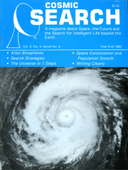![[NAAPO Logo]](../../Images/NAAPOsm.jpg) North American AstroPhysical Observatory (NAAPO)
|
|
People
By: John Kraus
Carl Sagan, of Cornell University, has produced a new 13-week television series "Cosmos" being presented this fall over Public Television. The production, funded by $8 million in grants, is a personal voyage through the cosmos touching on planets, stars, evolution, SETI and a host of other topics in an entertaining, instructive and responsible format. "Cosmos" is a welcome addition to the all-too-few outstanding science-education presentations available to the viewing public and should help to awaken a cosmic awareness in many people.
"Cosmos" is television at its very, very best.
Dr. Sagan is a member of the Editorial Board of COSMIC SEARCH.
The Reverend Theodore M. Hesburgh, President, University of Notre Dame, was presented the Sylvanus Thayer award of the U.S. Military Academy on September 11, 1980, in New York City. The award, representing the Academy's motto, "Duty, Honor, Country", was established in 1958. Dr. Hesburgh is a member of the Editorial Board of COSMIC SEARCH.
Richard E. Berendzen was invested as the 11th president of the American University, Washington, D.C., on September 18, 1980. Dr. Berendzen is a member of the Editorial Board of COSMIC SEARCH.
Norman Cousins of SATURDAY REVIEW has been appointed Adjunct Professor of Psychiatry and Behavioral Sciences at the University of California, Los Angeles. Dr. Cousins recently authored a new book "Anatomy of an Illness" (W.W. Norton) which is enjoying a wide sale. Dr. Cousins is a member of the Editorial Board of COSMIC SEARCH.
George E. Brown, Jr., Congressman from California, has introduced a bill in the 96th Congress (H.R. Bill Number 6304) designed:
George Gatewood of the University of Pittsburgh and Frank Drake of Cornell University have announced the formation of the Extrasolar Planetary Foundation aimed at mustering research support for the detection of planets which may be circling stars beyond the solar system. Dr. Gatewood will write a regular column for COSMIC SEARCH on the activities of the Foundation. His first column appears in this issue on page 12.
Robert A. Frosch has announced that he was resigning as Administrator of the National Aeronautics and Space Administration (NASA), effective January 20, 1981, to become the first president of the American Association of Engineering Societies, a federation created early this year comprising the major engineering societies of the United States. Dr. Frosch became the fifth head of NASA in June 1977.
A four-day seminar on "Macroengineering" was held at the Massachusetts Institute of Technology last summer. The slackening pace of the U.S. space efforts came under discussion. Some conferees voiced the opinion that large-scale projects will be difficult to achieve because of a growing political and corporate unwillingness to attack mankind's fundamental long-term problems.
A week-long conference in Rome featured astronomy and astronautics. Held last summer as a part of the Second International Festival of Poets it explored the philosophical consequences of mankind's surge into space. Whereas interest in space appears to be waning in the U.S. it is waxing in Europe. For example, the U.S.S.R.'s space program continues to move steadily ahead with ambitious plans for the 1980's.
John N. Wilford delved deeply into the divergent paths of the U.S. and Soviet space programs in "Science Times" (New York Times) for October 14, 1980. He reported that whereas the Soviet efforts aim toward establishing a permanent space station using, at least so far, older techniques, U.S. efforts center around the problem-ridden high-technology space shuttle.
Trudy E. Bell published a comprehensive report on "American Space Interest Groups" in the September 1980 issue of "Star and Sky". A table covering 4 pages gives detailed information and statistics on over three dozen American space organizations both professional and citizen supported.
Spectrum, the monthly publication of the Institute of Electrical and Electronics Engineers, carried 11 articles in the September 1980 issue on the general topic "They Said It Couldn't Be Done (and It Hasn't)". These articles give in-depth discussions of 11 important technological problems where breakthroughs and success have not been achieved. Some of the problems considered are the superconducting power cable, the electric automobile, magnetohydrodynamic power generation,
collision-proof airspace, an electronic "human eye", global video conferences, and a no-downtime computer. Who said that there are no challenges facing new electrical engineering graduates?
An UHURU Memorial Symposium is being held on December 13, 1980, at NASA's Goddard Space Flight Center to discuss the past, present, and future of x-ray astronomy. The symposium marks the 10th anniversary of the launching of UHURU (pronounced oo-who-ru), the first orbiting x-ray observatory.
The Astronomical Society of the Pacific (A.S.P.) is sponsoring a weekly syndicated astronomy column in an attempt to increase the number of clear, reliable astronomy reports available to newspaper readers. Called "Exploring the Universe" the weekly series concentrates on the most current and exciting concepts and discoveries in astronomy. If you are interested in more details about this column and how to get your local paper to carry it, write to Andrew Fraknoi, A.S.P., 1290 24th Ave., San Francisco, CA, 94122.
|
